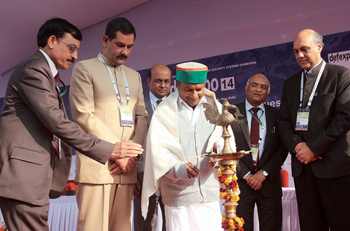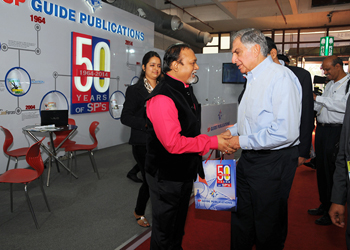INDIAN ARMED FORCES CHIEFS ON OUR RELENTLESS AND FOCUSED PUBLISHING EFFORTS

The insightful articles, inspiring narrations and analytical perspectives presented by the Editorial Team, establish an alluring connect with the reader. My compliments and best wishes to SP Guide Publications.

"Over the past 60 years, the growth of SP Guide Publications has mirrored the rising stature of Indian Navy. Its well-researched and informative magazines on Defence and Aerospace sector have served to shape an educated opinion of our military personnel, policy makers and the public alike. I wish SP's Publication team continued success, fair winds and following seas in all future endeavour!"

Since, its inception in 1964, SP Guide Publications has consistently demonstrated commitment to high-quality journalism in the aerospace and defence sectors, earning a well-deserved reputation as Asia's largest media house in this domain. I wish SP Guide Publications continued success in its pursuit of excellence.
- Appointments Committee of Cabinet approves one-month extension in service of Chief of the Army Staff
- Admiral Dinesh K. Tripathi assumes Command of the Indian Navy as 26th Chief of the Naval Staff
- Prime Minister witnesses 'Bharat Shakti' – a Tri-Services Firing and Manoeuvre Exercise in Pokhran, Rajasthan
- Interim Defence Budget 2024-25 — An Analysis
- Union Defence budget 2024
- Prime Minister Modi Commemorates Indian Navy Day in a Grand Ceremony
Defexpo: Charting the path for indigenisation



SP Guide Publications, which is celebrating its Golden Jubilee, yet again collaborated with the show organisers as the key official media partner. Collaborations, within and without, are the way forward.
This point was reiterated by the Minister of Defence A.K. Antony at the inaugural event and also in the press conference, that the pace of indigenisation in the defence industry would be accelerated and that there would be constant revisits to the various policies as to give that push. The original equipment manufacturers (OEMs) are aware of it and this is becoming increasingly noticeable as they are striking partnerships, joint ventures, agreements, memorandum of understanding, etc, with Indian companies. The base is being created and the results of which are expected to be borne in the near future and as the Minister mentioned the dependence on foreign equipment would come down to below 50 per cent from the present over 70 per cent in the next 5 to 10 years.
Indian companies to the fore
The Defence Research and Development Organisation (DRDO) was the largest domestic exhibitor which displayed its full range unmanned aerial vehicles and tanks. The largest overseas participation was from Russia, the largest arms supplier to India, with 37 companies followed by France at 24 and Israel at 21.
The Defence Minister said the exhibition provided foreign companies an opportunity to tie up with Indian companies to meet their targets under the defence offset policy, which is being modified to allow participation of more firms. The companies have Rs. 20,000 crore worth of commitments to fulfil up to 2022. The 26 per cent FDI cap which exists on defence purchases, he stated would be relaxed by the Government in case a vendor brings in state-ofthe-art technology. Indian companies had contributed Rs. 40,000 crore worth of equipment to the defence sector in 2012-13.
High points of Defexpo
Japan’s ShinMaywa continued to be in focus as India has expressed keen interest in its US-2 amphibian aircraft. There has been considerable movement as regards the process of acquisition and the second meeting of the joint working group is expected to meet in March. At the show, ShinMaywa showcased the different capabilities, including search and rescue on high seas, of the US-2.
Boeing displayed the Apache AH-64E attack helicopter, CH-47F Chinook heavy-lift transport helicopter, V-22 Osprey tilt-rotor aircraft and UAVs such as the ScanEagle. Rockwell Collins displayed its next-generation Talon RT-8400 international software-defined radio, a patrol persistent surveillance system and its HeliSure family of products.
Lockheed Martin was participating in the show for the first time and was gung-ho about the government’s ordering of second tranche of C-130J Super Hercules. Lockheed Martin presented its other capabilities including Javelin missile (in association with Raytheon), UAV platforms, etc.
Indian guns and others
The artillery gun segment also caught attention as India has embarked upon modernisation of the same and the market is said to be the size of $6 billion. Artillery guns from several Indian companies, Tatas, Kalyani Group, the Ordnance Factory Board (OFB), DRDO etc were presented. The OFB highlighted ‘Dhanush’ a 155mm 45-calibre gun with a range of over 38 km. The DRDO showcased, among other things, the Advanced Towed Artillery Gun (ATAG) project, to build a more powerful 155mm, 52-calibre gun. This gun will range out to 60 km, with a weight of just 12 tonnes. The Kalyani Group’s Bharat Forge has built its own gun, the Bharat-2. The group, which has tied up with Elbit Systems of Israel, showcased its 130-155mm fully upgraded gun system. BAE systems had a full team to explain the features of its M777 howitzer and other products.
DRDO also unveiled a 130mm self-propelled gun system, built based on the Arjun tank’s Mark 1 chassis. DRDO also highlighted its network-centric warfare system developed for the Navy.
Bharat Electronics displayed subsystems developed for use in various C4I systems catering to the Indian Army, Navy and Air Force. These included computing elements in various forms, including wrist-wearable computers, hand-held computers, tablets and rugged laptops. The systems also included communications equipment, such as software-defined radios with different variants and advanced interoperability communication systems.
Tata Group ominpresent
Tata companies were present in full strength. Tatas have been associated with the Indian defence sector for over 60 years. With a strategic focus of increasing indigenous production through development and transfer of technology, they have achieved global quality and cost benchmarks for exports. The group has partnered with the defence forces in the areas of weapon systems, command and control, and network-centric warfare including naval combat, air defence tactical communication, battlefield management systems and trusted computer platforms.
The key Tata companies which have programmes related to defence include TAL Manufacturing Solutions; Tata Advanced Systems; Tata Consultancy Services; Tata Elxsi; Tata Industrial Services; Tata Motors; Tata Power – Strategic Engineering Division; and Titan Company. Tata Motors displayed a new wheeled armoured amphibious platform and light armoured multi-purpose vehicles. The wheeled armoured vehicle, developed with DRDO, has interchangeable snap-in modules. The vehicle is integrated with the Raytheon-Lockheed Martin Javelin anti-tank guided missile system.
Larsen & Toubro, which has tied up with Nexter of France, unveiled a new version of its Caesar 155mm mounted gun system. The French company teamed up with the Indian companies L&T and Ashok Leyland Defence to offer a system fitted to Ashok Leyland’s six-wheel Super Stallion chassis.
Continued support from Russia
The largest contingent was from Russia with 37 companies at the show. The highlight included the Tor M2KM air defence missile system, which can detect and process up to 48 targets. The Russian ADS assault rifle, claimed to be the most modern in Russia, also was on display.
Expanding joint development and production efforts on weaponry and military equipment were among the key topics during talks between Rosoboronexport (part of the Rostec State Corporation) and Indian partners at Defexpo.
France extending its reach
With over 70 per cent of India’s defence and security equipment being imported and an expenditure budget for these acquisitions of 11.6 billion euros for 2013-14, India is currently one of the most attractive markets for the major arms exporting countries, including France, ranked fifth.
Since 1998 with the signature of a strategic partnership between France and India and confirmed by the 2006 bilateral agreement, defence and arms relations between the two countries have been extremely close. During the last decade, several French businesses have been awarded important contracts in India, including the modernisation of 51 units of the Mirage 2000, acquisition of 6 Scorpène submarines accompanied by the sale of 36 Exocet SM-39 antiship missiles for an announced amount of 2.4 billion euros. France looks forward to new developments in this privileged Franco-Indian relationship and hopes for intended and ongoing calls for tender for a supplementary set of high-sea submarines, projection and command ships, helicopters, artillery material as well as the 126 Rafale aircraft for which discussions are underway.
Israel displays wide range of capabilities
Israel was represented by 21 companies, the third largest contingent after Russia and France. Israel Aerospace Industries presented a wide range of strategic systems, including mission aircraft, a variety of UAVs, advanced radar systems, air defence systems and command and control gear for various theatres, including cyber.
Rafael displayed the Spike anti-tank guided munition, which is being considered for purchase by the Indian Army. The Iron Dome short-range artillery system was also on display. In addition, the company displayed the Python-5, Derby and MiC4AD air defence missiles.
All in all, the show is assuming importance as it is becoming a platform to strike partnerships. That is the mantra.





